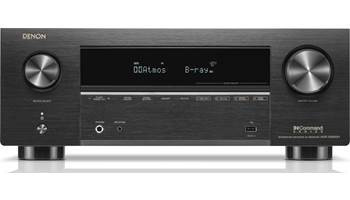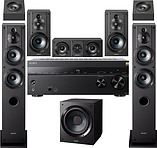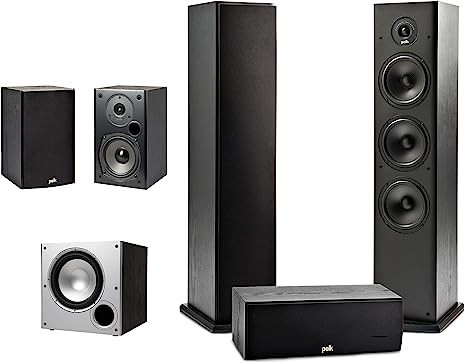Introduction
Home theater sound systems have become increasingly popular in recent years, as more and more people are looking to recreate the cinematic experience in the comfort of their own homes. A home theater sound system is a crucial component of any home entertainment setup, as it enhances the audio quality and immerses you in the action on screen. However, with so many options available on the market, it can be overwhelming to choose the right system for your home. In this article, we will explore the different components of a home theater sound system, factors to consider when choosing one, the importance of sound quality, wired vs. wireless options, top brands, budget-friendly options, advanced features, setting up and calibrating your system, and frequently asked questions. Pictured Above is a Polk Audio 5.1 surround speaker system.
Understanding the Components of a Home Theater Sound System
A home theater sound system consists of several components that work together to deliver high-quality audio. The main components include speakers, a receiver, a subwoofer, a soundbar, and cables and wires.
Speakers are perhaps the most important component of a home theater sound system. They come in various sizes and configurations, including floor-standing speakers, bookshelf speakers, and satellite speakers. The number of speakers you need will depend on the size of your room and your personal preferences. It is recommended to have at least five speakers for a surround sound setup – two front speakers, a center speaker, and two rear speakers.
The receiver is the central hub of your home theater sound system. It receives audio signals from your source devices, such  as a Blu-ray player or streaming device, and distributes them to the speakers. The receiver also amplifies the audio signals to ensure optimal sound quality. When choosing a receiver, make sure it has enough power to drive your speakers and supports the audio formats you want to use.
as a Blu-ray player or streaming device, and distributes them to the speakers. The receiver also amplifies the audio signals to ensure optimal sound quality. When choosing a receiver, make sure it has enough power to drive your speakers and supports the audio formats you want to use.
The subwoofer is responsible for reproducing low-frequency sounds, such as deep bass. It adds depth and impact to the audio, making explosions and other low-end effects more realistic. A good subwoofer can greatly enhance the overall viewing experience. When selecting a subwoofer, consider the size of your room and the power output of the subwoofer.
A soundbar is a compact speaker system that is designed to sit below your projctor screen
It is a popular choice for those who want to improve their audio experience without the need for multiple speakers. Soundbars come in various sizes and configurations, including 2.1, 3.1, and 5.1 channel setups. They are a great option for smaller rooms or for those who prefer a minimalist setup. They however will not replace a complete surround systems ability to immerse you in sound.
Cables and wires are essential for connecting all the components of your home theater sound system. Make sure to use high-quality cables that are capable of transmitting audio signals without any loss in quality. HDMI cables are commonly used for connecting source devices to the receiver, while speaker wires are used to connect the speakers to the receiver.
Factors to Consider When Choosing a Home Theater Sound System
When choosing a home theater sound system, there are several factors you should consider to ensure you get the best system for your needs.
Firstly, consider the size and layout of your room. The size of your room will determine the number and type of speakers you need. Larger rooms may require more powerful speakers or additional subwoofers to fill the space with sound. The layout of your room will also affect the placement of the speakers and the overall sound quality. It is important to choose a system that can be easily integrated into your room without compromising on audio performance.
Secondly, consider your budget. Home theater sound systems can range in price from a few hundred dollars to several thousand dollars. Set a budget that you are comfortable with and look for systems that fall within that range. Keep in mind that higher-priced systems often offer better sound quality and more advanced features, but there are also budget-friendly options available that can still deliver a great audio experience.
Next, consider your audio preferences. Do you prefer a more immersive surround sound experience, or are you satisfied with a simpler stereo setup? Do you listen to a lot of music or primarily use your system for watching movies and TV shows? These preferences will help determine the type of speakers and audio formats you should look for in a home theater sound system.
Lastly, consider the compatibility of the system with other devices. If you have other audio or video devices, such as a gaming console or streaming device, make sure the system you choose can easily connect to and work with these devices. Look for systems that have multiple input options, such as HDMI, optical, and Bluetooth, to ensure compatibility with a wide range of devices.
The Importance of Sound Quality in a Home Theater System
Sound quality is a crucial aspect of any home theater system, as it greatly affects the overall viewing experience. A high-quality sound system can transport you into the world of the movie or TV show, making you feel like you are right in the middle of the action. On the other hand, a poor-quality sound system can detract from the viewing experience and make even the most visually stunning scenes feel lackluster.
When it comes to sound quality, there are several factors to consider. Firstly, frequency response is an important aspect to look for in a home theater sound system. The frequency response refers to the range of frequencies that the system can reproduce. A wider frequency response means that the system can reproduce a greater range of sounds, resulting in more detailed and accurate audio.
Another important factor is dynamic range. Dynamic range refers to the difference between the quietest and loudest sounds that the system can reproduce. A system with a wide dynamic range can accurately reproduce both subtle nuances and explosive sound effects, resulting in a more immersive experience.
Additionally, consider the distortion levels of the system. Distortion refers to any unwanted changes or additions to the original audio signal. A system with low distortion levels will reproduce the audio signal accurately, without any added noise or distortion. Look for systems that have low Total Harmonic Distortion (THD) ratings for optimal sound quality.
Lastly, consider the soundstage and imaging capabilities of the system. The soundstage refers to the perceived location and width of the sound sources. A system with a wide soundstage can create a more immersive and realistic listening experience. Imaging refers to the ability of the system to accurately position sound sources within the soundstage. A system with good imaging capabilities can make you feel like you are surrounded by the sound, with distinct and precise placement of different audio elements.
Wired vs. Wireless Home Theater Sound Systems
When it comes to home theater sound systems, you have the option of choosing between wired and wireless setups. Each option has its own pros and cons, and the best choice for your home will depend on your specific needs and preferences.
Wired home theater sound systems are the traditional option and involve running cables from the receiver to each speaker. This setup provides a reliable and stable connection, ensuring that there is no loss in audio quality. Wired systems also tend to be more affordable, as they do not require any additional wireless technology. Additionally, wired systems do not suffer from interference issues that can sometimes occur with wireless setups.
However, wired systems can be more difficult to set up, especially if you have a large room or complex layout. Running cables through walls or under carpets can be time-consuming and may require professional installation. Additionally, wired systems can be less flexible, as you are limited by the length of the cables. If you decide to rearrange your room or move your system to a different location, you may need to reconfigure the cables.
On the other hand, wireless home theater sound systems offer more flexibility and convenience. With a wireless setup, you  can place the speakers wherever you want without the need for cables. This allows for easier installation and gives you the freedom to rearrange your room without having to worry about reconfiguring the cables. Wireless systems also tend to be more aesthetically pleasing, as there are no visible cables running across the room.
can place the speakers wherever you want without the need for cables. This allows for easier installation and gives you the freedom to rearrange your room without having to worry about reconfiguring the cables. Wireless systems also tend to be more aesthetically pleasing, as there are no visible cables running across the room.
However, wireless systems can be more expensive than wired systems, as they require additional technology to transmit the audio signals wirelessly. They can also be susceptible to interference from other wireless devices, such as Wi-Fi routers or cordless phones. This interference can result in a loss of audio quality or dropouts in the audio signal. Additionally, wireless systems may have a limited range, so if you have a large room or want to place speakers far away from the receiver, a wired setup may be more suitable.
Ultimately, the choice between wired and wireless home theater sound systems will depend on your specific needs and preferences. Consider factors such as the layout of your room, the ease of installation, and your budget when making your decision.
Top Brands in Home Theater Sound Systems
When it comes to home theater sound systems, there are several top brands that are known for their high-quality products and innovative features. These brands have established themselves as leaders in the industry and offer a wide range of options to suit different budgets and preferences.
One of the top brands in home theater sound systems is Bose. Bose is known for its premium audio products and is highly regarded for its sound quality and innovative technology. Bose offers a range of home theater sound systems, including soundbars, surround sound systems, and wireless speakers. Their systems are known for their sleek design, ease of use, and immersive sound experience.
regarded for its sound quality and innovative technology. Bose offers a range of home theater sound systems, including soundbars, surround sound systems, and wireless speakers. Their systems are known for their sleek design, ease of use, and immersive sound experience.
Another top brand is . Sonos is known for its wireless multi-room audio systems and offers a range of products that can be easily integrated into a home theater setup. Sonos systems are known for their ease of use, flexibility, and high-quality sound. They offer both soundbars and surround sound systems, allowing you to create a customized setup that suits your needs.
easily integrated into a home theater setup. Sonos systems are known for their ease of use, flexibility, and high-quality sound. They offer both soundbars and surround sound systems, allowing you to create a customized setup that suits your needs.
Sony is also a top brand in the home theater sound system market. Sony offers a range of products, including soundbars, surround sound systems, and wireless speakers. Sony systems are known for their high-quality sound, advanced features, and sleek design. They also offer compatibility with other Sony devices, such as TVs and gaming consoles, for a seamless user experience.
Other top brands in the home theater sound system market include Yamaha, Klipsch, and JBL Bar 5.1 system. Yamaha is known for its high- quality audio products and offers a range of options to suit different budgets and preferences. Klipsch is known for its powerful and dynamic sound, while JBL is known for its portable and wireless speakers. Pictured is the Yamaha Complete System.
quality audio products and offers a range of options to suit different budgets and preferences. Klipsch is known for its powerful and dynamic sound, while JBL is known for its portable and wireless speakers. Pictured is the Yamaha Complete System.
Each brand has its own unique features and strengths, so it is important to research and compare different options to find the best fit for your needs.
Budget-Friendly Home Theater Sound Systems
If you are on a tight budget, there are still options available for you to enjoy a high-quality home theater sound system without breaking the bank. Here are some budget-friendly options to consider:
1. Vizio: Vizio is a brand that offers affordable home theater sound systems without compromising on quality. They offer a range of soundbars and surround sound systems that deliver immersive audio at an affordable price. Vizio systems are known for their easy setup, sleek design, and good sound quality.
2. Polk Audio: Polk Audio is another brand that offers budget-friendly home theater sound systems. They offer a range of options, including soundbars, surround sound systems, and wireless speakers. Polk Audio systems are known for their clear and detailed sound, as well as their affordability.
3. Pioneer: Pioneer is a brand that offers affordable home theater sound systems with good sound quality. They offer a range of options, including soundbars, surround sound systems, and wireless speakers. Pioneer systems are known for their easy setup, versatility, and value for money.
When shopping for a budget-friendly home theater sound system, it is important to prioritize sound quality and features that are important to you. While you may not get all the advanced features and high-end sound quality of more expensive systems, there are still options available that can deliver a great audio experience at an affordable price.
Advanced Features to Look for in a Home Theater Sound System
If you are looking for a more advanced home theater sound system, there are several features to consider that can enhance your audio experience even further. These features can take your home theater setup to the next level and provide a more immersive and convenient user experience.
One advanced feature to look for is surround sound. Surround sound systems use multiple speakers to create a three-dimensional audio experience, with sounds coming from different directions. This can make you feel like you are right in the middle of the action and greatly enhance the overall viewing experience. Look for systems that support Dolby Atmos or DTS:X, as these formats provide the most immersive surround sound experience.
Another advanced feature to consider is voice control. Many home theater sound systems now come with built-in voice assistants, such as Amazon Alexa or Google Assistant. This allows you to control your system using voice commands, making it easier and more convenient to adjust settings or play music. Voice control can also integrate with other smart home devices, allowing you to control your entire home theater setup with just your voice.
Smart home integration is another advanced feature to look for. Many home theater sound systems now offer compatibility with smart home platforms, such as Apple HomeKit or Samsung SmartThings. This allows you to control your system using your smartphone or other smart devices, and integrate it with other smart home devices, such as smart lights or thermostats. Smart home integration can provide a seamless and integrated user experience, allowing you to control all aspects of your home theater setup from one central hub.
Other advanced features to consider include wireless connectivity options, such as Bluetooth or Wi-Fi, for easy streaming of music from your smartphone or other devices. Some systems also offer built-in streaming services, such as Spotify or Apple Music, allowing you to access your favorite music directly from the system. Additionally, look for systems that offer app control, allowing you to control and customize your system settings from your smartphone or tablet.
When choosing a home theater sound system with advanced features, it is important to consider your specific needs and preferences. Not all features may be necessary or useful for everyone, so prioritize the features that are most important to you and your home theater setup.
Setting Up Your Home Theater Sound System
Once you have chosen a home theater sound system, it is important to properly set it up for optimal sound quality:
Position your speakers correctly: The placement of your speakers can greatly affect the sound quality. Follow the manufacturer’s recommendations for speaker placement, taking into account factors such as room size and layout. Generally, the front speakers should be placed at ear level and equidistant from the screen. The center speaker should be placed a below the screen while the rear surround speakers are also placed at ear level preferably behind the listener.
manufacturer’s recommendations for speaker placement, taking into account factors such as room size and layout. Generally, the front speakers should be placed at ear level and equidistant from the screen. The center speaker should be placed a below the screen while the rear surround speakers are also placed at ear level preferably behind the listener.
Many receivers come with a microphone for calibrating the speakers. You can calibrate to the main seating position at center front of the front speakers and/or multiple locations to the front of the main speaker array.
Please add your comment, question or suggestion below.
